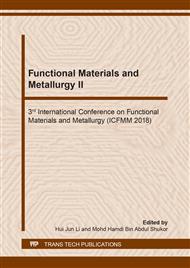p.51
p.59
p.65
p.71
p.79
p.86
p.92
p.98
p.104
Correlations between Milling Conditions and B2O3 Activity of Mechanically Activated Boron Concentrate
Abstract:
Facing the current inefficiency of boron extraction from boron concentrate, this paper used mechanical activation as a pretreatment method to improve the extraction of B2O3 from boron concentrate, and researched the influences of milling conditions, including the ball-sample mass ratio, the diameter of milling ball, and filling ratio of chamber, on the B2O3 activity. The changes in the properties of the milled products were investigated to analyze the mechanism of activation. These three milling conditions all affected the B2O3 activity more or less, as evidenced by the changes of B2O3 activity with these milling factors. Under optimized milling conditions, the B2O3 activity could be enhanced from 67.52% of the non-activated boron concentrate to 85.01%. The results also showed that the specific surface area increased and the crystal structure was damaged, which accelerated the reaction between the alkaline leaching solution and boron concentrate samples and enhanced the B2O3 activity of the samples.
Info:
Periodical:
Pages:
79-85
Citation:
Online since:
July 2019
Authors:
Price:
Сopyright:
© 2019 Trans Tech Publications Ltd. All Rights Reserved
Share:
Citation:


